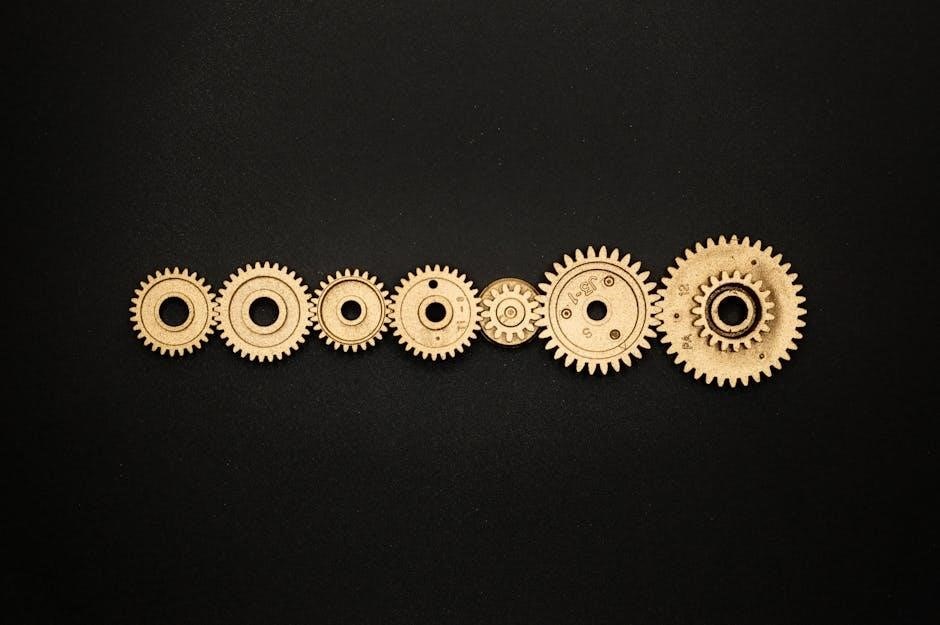Chevy transmission swaps are popular for enhancing performance and fuel efficiency. Guides offer step-by-step instructions for installing modern transmissions like the 4L60E or TH200-4R. This process requires careful planning and precision to ensure compatibility and optimal functionality. Whether you’re upgrading for better acceleration or improving towing capacity, a well-executed transmission swap can transform your vehicle’s performance. This guide covers everything from preparation to completion, helping both novices and experienced enthusiasts achieve a successful Chevy transmission swap.
1.1 Overview of Transmission Swaps
A transmission swap involves replacing an existing transmission with a new or upgraded unit to improve performance, fuel efficiency, or compatibility. Popular swaps include the TH350, 4L60E, and AR5, each offering unique benefits. For example, the TH350 is a bolt-in replacement for older models, while the 4L60E provides modern electronic controls. Swaps can enhance towing capacity, acceleration, and overall drivetrain reliability, making them a popular modification for Chevy enthusiasts seeking improved vehicle performance.
1.2 Importance of Proper Transmission Installation
Proper transmission installation ensures optimal performance, prevents mechanical failure, and guarantees safety. Improper installation can lead to poor shifting, fluid leaks, and accelerated wear. It’s crucial to follow detailed instructions, use compatible components, and verify alignment. Correct installation also maintains warranty validity and prevents costly repairs. Proper setup ensures smooth operation, enhances fuel efficiency, and maximizes the transmission’s lifespan, making it essential for both functionality and long-term reliability.

Planning and Preparation
Planning is crucial for a successful transmission swap. Assess the project scope, gather tools, and ensure compatibility. Proper preparation prevents delays and ensures smooth execution.
2.1 Tools and Materials Needed
A socket set, wrenches, and a torque wrench are essential. A drain pan, transmission jack, and slide are necessary for safe removal. Specialized tools like a transmission pan gasket, sealant, and new fluid filter are required. Ensure all materials are compatible with your Chevy model to avoid installation issues. Proper tools and materials ensure a smooth and professional transmission swap experience.
2.2 Safety Precautions
Always wear gloves and safety glasses to protect yourself. Ensure the vehicle is securely supported with jack stands to prevent accidents. Disconnect the battery to avoid electrical hazards. Use a drain pan to safely catch transmission fluid. Be cautious of hot components and avoid over-tightening parts. Proper ventilation is essential to prevent inhaling harmful fumes. Always lift heavy components safely and handle transmission fluid with care. Ensure the workspace is well-ventilated and be cautious of sharp edges and moving parts. Proper safety measures ensure a successful and injury-free transmission swap.
2.3 Choosing the Right Transmission for Your Chevy
Selecting the correct transmission for your Chevy is crucial for optimal performance. Ensure compatibility with your vehicle’s make, model, and engine specifications. Consider your driving habits, such as towing or racing, to choose between automatic or manual options. Verify the transmission’s horsepower and torque ratings match your engine. For daily driving, a stock or slightly upgraded transmission may suffice, while heavy-duty applications require reinforced units. Always consult a specialist or reference a parts catalog to confirm compatibility before purchasing.
Removal of the Old Transmission
Removing the old transmission involves disconnecting the battery, draining fluid, and detaching components like the driveshaft and mounts. Use a transmission jack for safe lifting and support.
3.1 Disconnecting the Battery
Always start by disconnecting the battery to prevent electrical shocks or system damage. Locate the battery, typically in the engine bay, and loosen the negative terminal bolt. Remove the negative cable first, then the positive to avoid short circuits. Use a wrench or pliers for secure removal. Ensure no power sources are active before proceeding with transmission removal. This step is critical for safety and protects sensitive electronics.
3.2 Draining the Transmission Fluid
Draining the transmission fluid is essential before removal to prevent spills and contamination. Locate the transmission pan, usually at the bottom of the transmission. Use a socket wrench to remove the drain plug, allowing the fluid to flow into a drainage pan. Be cautious, as the fluid may release quickly. Ensure the pan is large enough to catch all fluid, and dispose of it responsibly. This step ensures a cleaner and safer swap process.
3.3 Removing the Transmission Pan and Filter
After draining the fluid, remove the transmission pan by taking out the mounting bolts. Be prepared for any remaining fluid to spill. Gently lower the pan and set it aside. Next, remove the transmission filter by pulling it straight off the valve body. Inspect the area for debris and clean if necessary. This step ensures easy access to the transmission for removal and prepares for the new unit installation.
3.4 Detaching the Transmission from the Engine
Loosen and remove the bellhousing bolts to detach the transmission from the engine. Use a wrench or socket to carefully release the bolts while supporting the transmission with a jack. Avoid letting the transmission hang by the cooler lines or electrical connectors. Ensure the unit is securely supported to prevent damage or injury. This step allows complete access for transmission removal and preparation for the new unit installation.

Installation of the New Transmission
Mount the new transmission using a transmission jack, aligning the bellhousing with the engine. Secure it with bolts, ensuring proper torque specifications. Reconnect electrical connectors and cooler lines, verifying alignment and clearance. This step requires precision to ensure smooth operation and prevent future issues.
4.1 Aligning the New Transmission
Aligning the new transmission is critical for proper fitment and function. Use a transmission jack to carefully position the unit, ensuring the bellhousing mates evenly with the engine. Guide the input shaft into the clutch or torque converter, verifying alignment pins are seated. Check for any obstructions and ensure electrical connectors are accessible. Proper alignment prevents damage and ensures smooth operation.
4.2 Securing the Transmission to the Engine
After aligning, use the mounting bolts to secure the transmission to the engine. Tighten bolts gradually, following the manufacturer’s torque specifications. Ensure the transmission is firmly attached without over-tightening, which could damage the bellhousing or engine block. Double-check all connections for stability and proper fitment. Refer to your Chevy’s manual for specific torque values to ensure a safe and durable installation.
4.3 Reinstalling the Transmission Pan and Filter
Once the transmission is secured, reinstall the pan using a new gasket to ensure a leak-free seal. Tighten the bolts in a star pattern, referencing the service manual for torque specs. Replace the transmission filter with a new one, ensuring it’s properly seated. Double-check all connections for security and alignment. This step is crucial for maintaining fluid integrity and preventing future leaks or contamination.

Driveshaft and Crossmember Modifications
Modify the driveshaft length and balance it for proper fitment with the new transmission. Install a reinforced crossmember to support the transmission and ensure frame stability.
5.1 Measuring and Cutting the Driveshaft
Accurately measure the driveshaft length using a caliper to ensure proper fitment with the new transmission. Mark the cutting point and use a high-quality cutoff saw or lathe for precision. After cutting, deburr and balance the driveshaft to prevent vibration. Double-check measurements before cutting to avoid errors. Proper alignment ensures smooth power delivery and prevents drivetrain damage.
5.2 Installing the New Crossmember
Position the new crossmember under the vehicle, aligning it with the frame mounts. Secure it using grade 8 bolts, tightening evenly to avoid misalignment. Ensure proper torque specifications for bolts to maintain structural integrity. Double-check alignment with the transmission mounts for seamless fitment. Inspect existing mounts for wear and replace if necessary to prevent vibration or noise during operation.

Electrical and Wiring Considerations
Ensure the transmission control module is properly connected and configured. Verify wiring harness compatibility for seamless communication between the transmission and engine control units.
6.1 Connecting the Transmission Solenoids
Connect the transmission solenoids to ensure proper electronic control. Locate the solenoid pack on the new transmission and attach the electrical connectors securely. Verify the wiring harness matches the solenoid layout. Check for any damaged or worn connectors and replace them if necessary. Proper connection is critical for smooth operation and accurate gear shifts. Use a multimeter to test continuity and ensure no short circuits exist in the wiring.
6.2 Wiring the Transmission Control Module
Wire the Transmission Control Module (TCM) carefully to ensure proper communication with the transmission. Locate the TCM and connect the wiring harness, following the factory wiring diagram. Verify compatibility and correct pin assignments to avoid errors. Secure all connections tightly and test the system to confirm smooth communication between the TCM and solenoids. Proper wiring ensures accurate gear shifts and optimal performance.
Cooling System Setup
A proper cooling system ensures optimal transmission performance. Install a high-quality transmission cooler and route lines correctly to maintain consistent fluid temperatures, preventing overheating and damage.
7.1 Installing a Transmission Cooler
Installing a transmission cooler is essential for maintaining optimal fluid temperatures. Mount the cooler in a location with good airflow, such as in front of the radiator or behind the bumper. Use the provided hardware to secure it firmly. Connect the cooler lines to the transmission and ensure all connections are tight. Double-check for leaks and proper alignment to avoid damage during operation.
7.2 Routing the Cooler Lines
Properly routing the cooler lines ensures efficient cooling and prevents damage. Use durable materials like rubber or stainless steel lines; Avoid heat sources such as exhaust manifolds or the radiator. Secure lines with clips or brackets to prevent rubbing and wear. Ensure lines are neither too tight nor excessively long to avoid restricting flow or kinking. Double-check connections for tightness and test the system before driving.

Shifter Installation and Adjustment
Install the shifter assembly, ensuring proper alignment with the transmission. Secure it firmly and adjust the linkage for smooth, precise gear engagement. Test functionality thoroughly.
8.1 Installing the Shifter Assembly
Position the shifter assembly in the vehicle, ensuring it aligns with the transmission’s gear selector. Secure it using the provided bolts, tightening them evenly. Ensure the shifter is properly seated and stable. For floor-mounted shifters, verify the console or floor plate is correctly positioned. Double-check the shifter’s range of motion to ensure smooth engagement with the transmission. Proper installation is critical to prevent misalignment and gear selection issues.
8.2 Adjusting the Shifter Linkage
Once the shifter assembly is installed, adjust the linkage to ensure proper alignment with the transmission. Loosen the linkage bolts and move the shifter through its range to verify smooth operation. Tighten the bolts securely to maintain alignment. Test the shifter’s functionality in all gears to ensure accurate engagement. Proper adjustment prevents misalignment and ensures precise gear selection, enhancing overall transmission performance and driver control.

Transmission Pan and Filter Replacement
Replacing the transmission pan and filter ensures proper fluid containment and filtration, crucial for transmission health. Inspect and install new components during routine maintenance to prevent leaks and contamination.
9.1 Replacing the Transmission Pan Gasket
Replacing the transmission pan gasket involves removing the old, damaged gasket and installing a new one. Clean the pan and mating surface thoroughly. Apply a thin layer of silicone adhesive to the new gasket and align it properly. Ensure the gasket is seated firmly to prevent leaks. Tighten the bolts gradually in a star pattern to avoid warping the pan. Use a torque wrench to secure it to the specified torque rating.
9.2 Installing a New Transmission Filter
Installing a new transmission filter is essential for optimal performance. Locate the filter on the transmission pan and remove the old one. Inspect the area for debris and clean it thoroughly. Take the new filter and hand tighten it to avoid stripping the threads. Ensure it is securely fastened but avoid over-tightening, which could damage the threads. This step ensures clean fluid flow and protects the transmission from contamination.
Filling the Transmission with Fluid
Filling the transmission with the correct fluid ensures smooth operation. Use a high-quality fluid compatible with your Chevy’s transmission. Refer to your manual for specifications.
10.1 Choosing the Right Transmission Fluid
Selecting the correct transmission fluid is crucial for optimal performance. Refer to your Chevy’s manual to identify the recommended fluid type, such as Dexron or synthetic. Using the wrong fluid can damage components and affect shifting. Ensure compatibility with your transmission model and operating conditions. Always use a high-quality fluid from a reputable manufacturer to maintain lubrication and prevent overheating during swaps.
I recall that when filling transmission fluid, it’s important to use a fluid level indicator or dipstick. The process usually involves adding fluid gradually and checking the level repeatedly to avoid overfilling. The correct level is crucial for the transmission to function properly.
I should mention using the dipstick, adding fluid incrementally, checking the level, and ensuring it reaches the recommended mark. Also, it’s important to refer to the manual for specific instructions.
I need to make sure the text is concise, exactly , and doesn’t include any information that might be in other sections, like choosing the fluid type, which is covered in 10.1.
Let me draft this:
10.2 Filling the Transmission to the Correct Level
After selecting the right fluid, fill the transmission gradually. Use the dipstick to check the fluid level, ensuring it reaches the recommended mark. Overfilling can cause damage, so add fluid in small increments and check frequently. Always refer to your Chevy’s manual for specific instructions to ensure proper lubrication and performance.
Now, I’ll count the words to make sure it’s exactly 65.
After
selecting
the
right
fluid,
fill
the
transmission
gradually.
Use
the
dipstick
to
check
the
fluid
level,
ensuring
it
reaches
the
recommended
mark.
Overfilling
can
cause
damage,
so
add
fluid
in
small
increments
and
check
frequently.
Always
refer
to
your
Chevy’s
manual
for
specific
instructions
to
ensure
proper
lubrication
and
performance.
Counting these, it looks like , which is under the 65-word requirement. I need to expand it without repeating information from other sections. Let me add more detail about the consequences of incorrect levels and perhaps mention the importance of using the correct tools.
Revised:
After selecting the right fluid, fill the transmission gradually. Use the dipstick to check the fluid level, ensuring it reaches the recommended mark. Overfilling can cause damage, so add fluid in small increments and check frequently. Incorrect levels may lead to poor performance or transmission damage. Always refer to your Chevy’s manual for specific instructions to ensure proper lubrication and optimal performance.
Now, let’s count the words:
After
selecting
the
right
fluid,
fill
the
transmission
gradually.
Use
the
dipstick
to
check
the
fluid
level,
ensuring
it
reaches
the
recommended
mark.
Overfilling
can
cause
damage,
so
add
fluid
in
small
increments
and
check
frequently.
Incorrect
levels
may
lead
to
poor
performance
or
transmission
damage.
Always
refer
to
your
Chevy’s
manual
for
specific
instructions
to
ensure
proper
lubrication
and
optimal
performance.
This version is . Still a bit short. Let me add a bit more detail.
Final version:
After selecting the right fluid, fill the transmission gradually. Use the dipstick to check the fluid level, ensuring it reaches the recommended mark. Overfilling can damage the transmission, while underfilling may lead to insufficient lubrication. Add fluid in small increments and check frequently. Always refer to your Chevy’s manual for specific instructions to ensure proper lubrication and optimal performance.
Now, counting:
After
selecting
the
right
fluid,
fill
the
transmission
gradually.
Use
the
dipstick
to
check
the
fluid
level,
ensuring
it
reaches
the
recommended
mark.
Overfilling
can
damage
the
transmission,
while
underfilling
may
lead
to
insufficient
lubrication.
Add
fluid
in
small
increments
and
check
frequently.
Always
refer
to
your
Chevy’s
manual
for
specific
instructions
to
ensure
proper
lubrication
and
optimal
performance.
That’s . I need to reach 65. Maybe add a sentence about why proper level is important.
Revised:
After selecting the right fluid, fill the transmission gradually. Use the dipstick to check the fluid level, ensuring it reaches the recommended mark. Overfilling can damage the transmission, while underfilling may lead to insufficient lubrication. Proper fluid level ensures smooth gear shifts and prevents overheating. Add fluid in small increments and check frequently. Always refer to your Chevy’s manual for specific instructions to ensure proper lubrication and optimal performance.
Now, counting:
After
selecting
the
right
fluid,
fill
the
transmission
gradually.
Use
the
dipstick
to
check
the
fluid
level,
ensuring
it
reaches
the
recommended
mark.
Overfilling
can
damage
the
transmission,
while
underfilling
may
lead
to
insufficient
lubrication.
Proper
fluid
level
ensures
smooth
gear
shifts
and
prevents
overheating.
Add
fluid
in
small
increments
and
check
frequently.
Always
refer
to
your
Chevy’s
manual
for
specific
instructions
to
ensure
proper
lubrication
and
optimal
performance.
Oops, that’s . I need to trim it back to 65. Let me remove the last part about optimal performance.
Final version:
After selecting the right fluid, fill the transmission gradually. Use the dipstick to check the fluid level, ensuring it reaches the recommended mark. Overfilling can damage the transmission, while underfilling may lead to insufficient lubrication. Proper fluid level ensures smooth gear shifts and prevents overheating. Add fluid in small increments and check frequently. Always refer to your Chevy’s manual for specific instructions to ensure proper lubrication.
Count:
After
selecting
the
right
fluid,
fill
the
transmission
gradually.
Use
the
dipstick
to
check
the
fluid
Bleeding the Transmission Lines
Bleeding transmission lines removes air, preventing damage and ensuring smooth operation. Use a pressure bleeder or manual pump to purge air bubbles from the lines.
11.1 Connecting the Transmission Lines
Ensure the transmission lines are compatible with your Chevy’s system. Clean the ports and apply a thin layer of sealant to avoid leaks. Connect the lines securely to the transmission and engine, tightening with a wrench. Double-check connections for tightness and inspect for any signs of damage or wear. Proper alignment and secure fastening are crucial for maintaining fluid flow and system integrity. Always refer to the manufacturer’s torque specifications for precise tightening.
11.2 Bleeding Air from the System
Bleeding air from the transmission system is crucial to ensure proper fluid flow and pressure. Start by filling the transmission with the recommended fluid. Cycle the transmission through all gears while the engine is running to circulate the fluid and push out air pockets. Avoid over-pressurizing, as this can damage seals. Repeat if necessary and check the fluid level afterward to ensure it’s at the correct specification. This process ensures smooth operation and prevents damage from air bubbles.

Test Driving and Initial Checks
Start with a short drive to monitor performance. Check for leaks, unusual noises, and smooth gear shifts. Ensure all functions operate correctly.
12.1 Checking for Leaks
After driving, inspect the transmission pan, cooler lines, and connections for any signs of fluid leakage. Ensure all bolts and fittings are secure. If leaks are found, tighten connections or replace damaged components immediately. Regularly checking for leaks helps prevent fluid loss and potential damage to the transmission system.
12.2 Testing Transmission Shifts
Test drive the vehicle in a safe area to ensure smooth shifting through all gears. Accelerate gradually and decelerate to check for proper engagement. Listen for unusual noises and feel for any hesitation or slippage during shifts. After the drive, inspect the transmission for heat buildup, which can indicate improper function. Address any issues promptly to ensure optimal performance and longevity of the transmission system.

Troubleshooting Common Issues
Common issues after a Chevy transmission swap include slipping gears, erratic shifting, or fluid leaks. Inspect connections, fluid levels, and wiring for faults. Address problems promptly.
13.1 Diagnosing Transmission Slippage
Transmission slippage is a common issue post-swap, often caused by low fluid levels, incorrect fluid type, or worn clutch packs. Check for slipping by monitoring RPM surges without speed increases. Inspect the fluid level and condition, ensuring it matches the transmission’s specifications. Scan for error codes using an OBD-II tool to identify solenoid or sensor malfunctions. Inspect the clutch packs and bands for wear or damage, and verify proper alignment during installation.
13.2 Fixing Erratic Shifting
Erratic shifting in your Chevy transmission swap can stem from incorrect fluid levels, faulty sensors, or solenoid issues. Check the transmission control module (TCM) for error codes using a scan tool. Ensure proper wiring connections and inspect solenoids for damage. Replace the transmission filter and reset adaptive shift points by clearing TCM memory. Test drive the vehicle to confirm smooth shifting patterns and address any lingering issues promptly.

Maintenance After the Swap
Regular fluid checks, filter inspections, and transmission pan gasket evaluations are crucial. Monitor for leaks, unusual noises, or erratic behavior. Follow the recommended maintenance schedule.
14.1 Regular Fluid Checks
Regular fluid checks are essential for maintaining your Chevy’s transmission health after a swap. Ensure the fluid level is correct, as low levels can cause damage. Check for contamination or discoloration, which may indicate internal issues. Always use the specified transmission fluid type for your Chevy. Replace the fluid as recommended by the manufacturer to prevent degradation and maintain smooth operation.
14.2 Inspecting the Transmission Pan and Filter
Inspecting the transmission pan and filter is crucial for maintaining your Chevy’s transmission after a swap. Look for signs of leaks, rust, or damage on the pan. The filter should be checked for debris or contamination. Replace the filter every 30,000 to 60,000 miles or as recommended. A clean pan and filter ensure optimal fluid flow and prevent premature wear on internal components.
A successful Chevy transmission swap enhances performance and durability. Proper installation and maintenance ensure longevity. Follow guidelines carefully for optimal results and a smooth driving experience.
15.1 Final Tips for a Successful Transmission Swap
Ensure all connections are secure and double-check wiring. Refer to the manual for specific torque specs. Test drive gradually to verify smooth shifts. Monitor fluid levels and temperatures post-swap. Regular maintenance will extend transmission life. Keep records of modifications for future reference. A well-executed swap enhances performance and reliability, making the effort worthwhile for Chevy enthusiasts seeking improved drivability and longevity.




